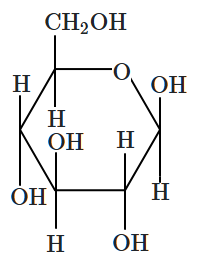What is the number of stereocenters in the linear and cyclic forms of glucose, respectively?
| 1. | 4 & 4 | 2. | 4 & 5 |
| 3. | 5 & 4 | 4. | 5 & 5 |
Subtopic: Carbohydrates - Classification & D-L configuration |
67%
From NCERT
JEE
Please attempt this question first.
Hints
Please attempt this question first.
The term anomers of glucose refer to:
| 1. | Isomers of glucose that differ in configurations at carbons one and four (C-1 and C-4) |
| 2. | A mixture of (D)-glucose and (L)-glucose |
| 3. | Enantiomers of glucose |
| 4. | Isomers of glucose that differ in configuration at carbon one (C-1) |
Subtopic: Carbohydrates - Classification & D-L configuration |
68%
From NCERT
JEE
Please attempt this question first.
Hints
Please attempt this question first.
Match List–I (Carbohydrates) with List – II (Cyclic Structures) and select the correct option:
1. A – 4; B – 1; C – 2; D – 3
2. A – 1; B – 4; C – 3; D – 2
3. A – 2; B – 3; C – 4; D – 1
4. A – 1; B – 3; C – 2; D – 4
| List - I (Carbohydrates) |
List - II (Cyclic Structures) |
||
| A. | α − D −Glucopyranose | 1. |  |
| B. | β −D − Glucopyranose | 2. |  |
| C. | α − D − Fructofuranose | 3. |  |
| D. | β − D −Fructofuranose | 4. |  |
1. A – 4; B – 1; C – 2; D – 3
2. A – 1; B – 4; C – 3; D – 2
3. A – 2; B – 3; C – 4; D – 1
4. A – 1; B – 3; C – 2; D – 4
Subtopic: Carbohydrates - Classification & D-L configuration |
73%
From NCERT
JEE
Please attempt this question first.
Hints
Please attempt this question first.
Which of the following cyclic forms represents the pyranose form of the linear carbohydrate shown in the image?

| 1. |  |
2. |  |
| 3. |  |
4. |  |
Subtopic: Carbohydrates - Classification & D-L configuration |
72%
From NCERT
JEE
Please attempt this question first.
Hints
Please attempt this question first.
A biomolecule gives the following observations:
The correct structure of the biomolecule, from the following, is:
| (i) | With Br2/H2O, it gives monocarboxylic acid |
| (ii) | With acetate, it gives tetraacetate |
| (iii) | With HI/Red P, it gives isopentane |
The correct structure of the biomolecule, from the following, is:
| 1. |  |
2. |  |
| 3. |  |
4. |  |
Subtopic: Carbohydrates - Classification & D-L configuration |
51%
From NCERT
JEE
Please attempt this question first.
Hints
Please attempt this question first.
Which of the following is the correct structure of L-glucose?
| 1. |  |
2. |  |
| 3. |  |
4. |  |
Subtopic: Carbohydrates - Classification & D-L configuration |
57%
From NCERT
JEE
Please attempt this question first.
Hints
Please attempt this question first.
Given below are two statements:
| Statement I: | Fructose does not contain an aldehydic group but still reduces Tollen’s reagent. |
| Statement II: | In the presence of base, fructose undergoes rearrangement to give glucose. |
| 1. | Statement I is false but Statement II is true. |
| 2. | Both Statement I and Statement II are true. |
| 3. | Both Statement I and Statement II are false. |
| 4. | Statement I is true but Statement II is false. |
Subtopic: Carbohydrates - Classification & D-L configuration |
66%
From NCERT
JEE
Please attempt this question first.
Hints
Please attempt this question first.




